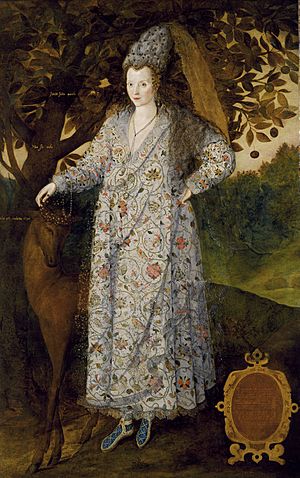Aura Soltana facts for kids
Aura Soltana, also known as Ipolitan the Tartarian or Ipolita, was a young woman from Tartary. She came to England from Russia and joined the court of Elizabeth I. She was possibly brought to England in a way that wasn't free.
Contents
Aura Soltana: Her Story
Aura Soltana's story is found in old records from Queen Elizabeth's time. She was also known as "Ippolyta" or "Ipolitan the Tartarian."
How She Came to England
The sailor Anthony Jenkinson brought Aura Soltana to England from Russia. In 1559, Jenkinson wrote a letter mentioning "my wench Aura Soltana." A historian named Richard Hakluyt later said this was "a young Tartar" who Jenkinson gave to the Queen. Jenkinson also wrote that a "Nagayan Tartar slave" in Astrakhan cost about sixpence, which was the price of a loaf of bread in England.
Life at Queen Elizabeth's Court
Records from Queen Elizabeth's court often mention "Ipolitan the Tartarian." Experts believe this is the same person. Her story is linked to international trade and the Muscovy Company. This company traded goods like eastern silks and Russian furs.
On July 13, 1561, Aura Soltana was christened. This means she was officially welcomed into the Christian church. The Queen gave her special gifts: a gold chain and a gold locket. These gifts were given to "Ipolitan the Tartarian." There is no clear proof that Queen Elizabeth was her godmother. In 1564, she received new clothes, which were listed in great detail.
Gifts and Daily Life
In 1562, a pewter doll was bought for Aura Soltana to play with. She also received many fancy clothes, including some of the Queen's old garments. The doll was given to Kat Ashley, who likely looked after Aura Soltana. She was also given Farthingale pins. This suggests her court outfits were similar to those worn by other young women.
The shoemaker Garret Johnson made several pairs of shoes for Aura Soltana. This might mean she was still growing. Her shoes were made from different materials, including leather, Spanish leather, and velvet. Interestingly, Queen Elizabeth's own shoes before this time were all made of velvet. Some historians think the Queen might have started wearing Spanish leather shoes after seeing Aura Soltana's.
One of the last mentions of Aura Soltana at court was in 1569. An order was made for a furrier named Adam Bland to add rabbit fur to her damask cloak.
Her Clothes in 1561 and 1564
Queen Elizabeth often gave her old clothes as gifts. In May 1561, she gave clothes to a "Tartarian woman." This might have been Aura Soltana or someone with her. These gifts included two loose black taffeta gowns and two French kirtles (a type of skirt) made of satin.
In June 1564, "Ipolita the Tartarian" received many specific clothes. These items show her connection to the global trade of luxury goods. The clothes were similar to what other young women at court wore. Here are some examples:
- A gown and kirtle made of damask, trimmed with velvet.
- Another gown and kirtle made of grosgrain chamlet, also trimmed with velvet.
- A petticoat of red cloth or grosgrain.
- A farthingale (a hoop skirt) made of mockado.
- Six canvas smocks (undershirts) with linen sleeves.
- Six kerchiefs and six partlets (neck coverings) with bands and ruffs.
- Four pairs of linen sleeves.
- Thread for making and embroidering her clothes, including Granada silk and Venice gold thread.
- A "clout" of Spanish needles (a cloth with needles pinned to it).
- A scarf made of sarcenet.
- A velvet hat.
- Two hairnets (cauls) made of gold, silver, and silk, which were quite expensive.


